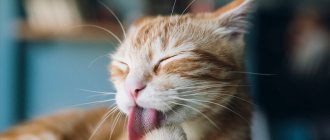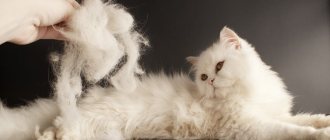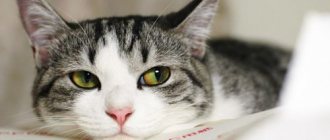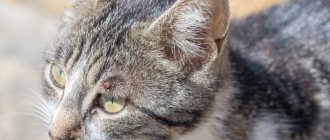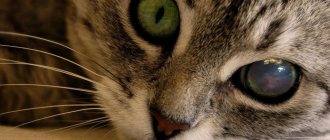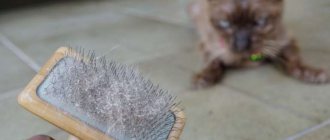If a cat loses some of its fur, this is normal and a natural process. However, in situations where the amount of hair on the floor and surrounding objects increases, and the hairiness of a domestic cat, on the contrary, decreases, this is a reason to think about the state of the animal’s health.
Some causes of hair loss are completely harmless, but others can be serious.
So, the cat's hair is falling out. The main reasons can be: natural (molting, age-related), health problems (poor diet, hormonal imbalance, allergies), parasites (worms, lice eaters, subcutaneous and scabies mites), problems with the immune system.
Natural causes
First, you need to pay attention to the appearance of the animal and its general condition in order to determine the causes of hair loss. The main signs that a cat is healthy include:
- the animal’s nose is moist and of a color usually characteristic of it;
- the eyes are clean, clear, without any discharge;
- there is no irritation on the skin, it is of normal color;
- The animal’s behavior is cheerful and no different from everyday behavior.
With all these signs, we can say for sure that the cat is just having a normal shedding.
Typical symptoms
Signs of developing alopecia are easy to detect even without veterinary education. The first symptom is thinning hair on the sides of the body, behind the ears, and in the tail area. Progressive pathology provokes the appearance of other characteristic signs:
- hair loss in large clumps;
- exposing areas of skin that acquire a pink or reddish tint;
- formation of unsightly crusts in areas affected by alopecia.
If your cat is going bald due to a serious medical condition, sores, scabs, or whitish bumps may form in the problem areas. The skin in the bald area sometimes becomes hot and loses its natural elasticity.
Many cats with alopecia become restless, experience constant discomfort, and avoid contact with their owners in every possible way. A cat may constantly lick and scratch hairless areas of the body, further injuring them.
With Itsenko-Cushing's disease, which affects cats in isolated cases, the animals not only go bald. Other symptoms are also observed - increased hunger and thirst, an increase in the size of the abdomen, and thinning of the epidermis.
Shedding
If a cat's fur falls out in clumps, the reasons may be very trivial. Animals in the wild change their coat twice a year: in autumn and spring. In domestic animals, this process is disrupted, since they are removed from their natural habitat. For example, in the fall, when all animals in nature build up a warm undercoat for winter, the reverse process begins in domestic cats. This is due to the fact that the heating is turned on during this period of time. The air in the apartment becomes hot and dry, so your pet is in a hurry to get rid of excess fur. Moreover, at home, the molting process can take much longer than in natural conditions. This is completely normal. The fact that an animal is actively changing its coat is not a cause for concern.
All you need to do is make sure that your cat's diet is balanced and rich in vitamins and minerals. If there are not enough of them in the diet, you can compensate for this deficiency. It is enough to purchase special vitamin and mineral complexes at any pet store.
You need to comb the animal more often. On normal days, sessions should be carried out once every 7-30 days, but when the molting period begins, the procedure becomes daily. And if your pet has long hair, you will have to comb it twice a day. And even this will not get rid of the daily use of a vacuum cleaner.
How to carry out treatment?
If your cat's fur is falling out in clumps, ask your veterinarian what to do.
To make a diagnosis, laboratory and instrumental studies are used:
- blood analysis;
- skin scraping;
- use of Wood's lamp;
- hair examination;
- Ultrasound;
- X-ray.
Depending on the identified cause, the mustachioed patient is prescribed surgical or drug therapy. In case of hormonal imbalances, castration is performed, and if oncology is detected, the tumor is excised.
Among the drugs used:
- sedatives that reduce stress levels;
- antibacterial and antifungal, fighting bacterial and fungal infections;
- antihistamines, which suppress the production of histamine during allergies;
- antiparasitic, destroying fleas, ticks and helminths;
- immunostimulants that stimulate the work of immune cells.
In addition to taking medications, antiseborrheic shampoos, ointments and antiseptics are prescribed to treat suppurations. If a food allergy is suspected, the animal is placed on a strict diet.
Age
It is very important for owners to understand as early as possible why cats lose hair in clumps. The reasons can be completely different, from dangerous to completely harmless. Baldness of the muzzle and partial loss of hair are another common condition of the animal. This process manifests itself in pets aged from 14 months to 20. This condition is caused by quite normal age-related changes in the coat. When the animal reaches the appropriate age, this phenomenon will go away on its own, so you should not run to the veterinarian.
How to help a cat
Treatment is selected taking into account the general health of the pet and the factors that provoked baldness.
Medications
After determining the cause of baldness, certain groups of drugs are prescribed:
Allergy. Immunostimulating and antihistamines are prescribed.- Parasites. They resort to the use of antiparasitic drugs.
- Infection. Antibiotics are used, for example Amoxicillin.
- Stress. Drugs that have a sedative effect are used.
- Lichen. Antifungal agents are prescribed. The most commonly used are Ketoconazole or Griseofulvin. In addition, agents are used that stimulate metabolic processes and support immunity.
- Endocrine system disorders. Hormonal medications are indicated.
Traditional medicine
Resorting to the use of folk remedies is strongly discouraged. Often, when using them, there is a deterioration in the animal’s condition.
In addition to drug therapy, it is worth excluding potential allergens from your pet’s menu and providing him with peace. Self-medication is strictly prohibited .
Poor nutrition
At any age, the animal's diet must be balanced. Feeding from your own table is the most common mistake a pet owner makes. With this approach, the animal’s bowl may contain everything that is strictly prohibited for cats: fried foods, sausages, various scraps, leftover salty and fatty foods.
The answer to the question of why a cat's fur falls out in clumps may be a simple desire to save money. For example, the owner buys dry food from the cheapest line. Yes, such food will help your pet get enough, but it will also bring many health problems. After all, its composition is not always optimal, so the effect of such food on the animal’s body can be destructive.
It is worth understanding that choosing a diet is a very important process. It is better to choose dry food from the super-premium or premium category. This diet is balanced and contains all the necessary microelements. Although it costs, of course, more than advertised budget products. But using low-quality food will cost much more, as it will provoke a trip to the veterinarian and long-term treatment.
To determine why a cat’s hair is falling out in clumps, and to understand that the reason lies precisely in the food and improper diet, it is necessary to take into account the following symptoms:
- the main pieces of hair fall out on the back, neck and tail;
- on all other parts of the body the fur began to fade;
- discharge appeared from the eyes, and they themselves became cloudy;
- the ears are inflamed and itchy;
- The bald spots that have arisen at the site of the fallen tufts are inflamed and itchy, the layers of skin in these places have begun to peel off, the animal scratches itself so that sores appear.
Hair loss in kittens
The kitten's body is especially sensitive. The appearance of alopecia can be caused by infection, too early birth, or a small amount of vitamins in the diet.
In addition to hypotrichosis, kittens often suffer from adenitis of the sebaceous glands. Sick pets have bald heads, ears and necks. Bald areas take the shape of a circle. Damaged skin peels and smells unpleasant. If left untreated, bald patches spread to the back and base of the ponytail. Inflamed glands cause severe itching, so your pet is constantly itching. The exfoliated scales become moist and acquire a yellow or gray tint.
Correcting the situation
Solving this problem is quite simple: it is necessary to adjust the pet’s diet in accordance with its needs, and replace low-quality food with healthier ones.
There are situations where hair begins to fall out even when the cat eats a high-quality product. This may be due to individual intolerance to a certain food. In this case, you just need to replace it with another one. Its class should be the same, but the composition is different or even a completely different manufacturer.
Hormonal disbalance
This situation most often occurs due to the use of hormonal drugs, such as drops or tablets, which reduce the animal’s sex drive. Thanks to these means, the pet stops marking its territory and demanding a partner. However, such violent interference with hormonal levels does not pass without leaving a trace. If, after using such drugs, a cat’s hair falls out in clumps to the point of bald spots, the cat becomes lethargic, indifferent, eats poorly, and begins to see or hear worse, in most cases this indicates that a hormonal imbalance has occurred. This problem should be solved by a veterinarian by prescribing corrective therapy. Timely sterilization or castration allows you to avoid such problems.
Treatment depending on the cause
Treatment for alopecia becomes effective once its causes are correctly identified. It will be possible to establish the pathological factors that caused the disorder only after a detailed diagnosis.
If the cat begins to go bald, you will need to decide what to do together with your veterinarian. Before prescribing a course of treatment, the doctor will conduct a thorough examination of the pet and conduct a conversation with its owners. The following diagnostic methods will help you make a correct diagnosis:
- taking hair roots from the patient for subsequent examination under a microscope;
- general blood test;
- scraping from affected areas of the body;
- ultrasound or x-ray examination of internal organs (if the cat is suspected of having tumors).
The subsequent fight against the disorder is aimed at eliminating the underlying disease that provoked the thinning of the coat.
Treatment for a cat that is going bald is not quick and takes a considerable period of time. For successful hair restoration, all procedures must be done in accordance with the recommendations of a veterinarian. If the process is started, it is quite difficult to return the animal to normal coat.
What to do about baldness caused by infections
If the infectious nature of the disorder is confirmed, cats are prescribed:
- antiviral drugs (Kanamycin, Ribaflox);
- antibiotics (Amoxicillin, Ceftriaxone).
When affected by the fungus that causes ringworm, a combination of topical and internal agents is necessary. Sanoderm ointment, Mycostop ProVET spray, Orungal tablets, Ketoconazole are indicated for animals.
For cheyletiellosis, the main emphasis is on the use of skin preparations. It is possible to destroy parasites that cause thinning of the coat with the help of Ivermek spray, Demos, Butox.
In addition to the main treatment, you will need to enrich the cat’s menu with vitamins and bathe your pet often. Cat dishes and accessories and all rooms must be thoroughly sanitized. When affected by parasites, animals are cut short.
Combating allergies and hormonal problems
First of all, in case of baldness of allergic origin, all irritants must be identified and eliminated. Animals are prescribed anti-allergenic drugs:
- antihistamines;
- steroids;
- preparations with vitamin B 7.
The problem of a hormonal nature is eliminated with hormone-containing drugs. If a cat is going bald due to tumors in the thyroid gland, surgical intervention is prescribed.
The cat's diet includes lean boiled meat, fish, quail eggs, cereals, and vegetables. To prevent infection by parasites or food poisoning, you should carefully handle food and ensure its freshness.
What to do when your cat goes bald from stress
Cats that are going bald due to increased anxiety are prescribed sedatives. It is possible to improve the emotional background thanks to the following drugs:
- "Stop the stress."
- Relax Plus.
- "Zoomir Antistress".
- Fitex.
It will be necessary to normalize the situation in the house, to eliminate factors that traumatize the sensitive psyche of the animal. The cat needs to be provided with toys and places where it could hide in case of fear or stress.
It is important for cat owners to know what to do to prevent alopecia. Prevention of pathology includes a balanced diet of animals, vaccination, and periodic use of antiparasitic agents. Careful hygiene of cats, a favorable psychological climate in the house, and no contact with sick individuals are required.
Allergy
In most cases, as in humans, an allergic reaction in an animal manifests itself on the skin. The hair falls out symmetrically in parallel, redness appears on the skin, and the ears become inflamed and itchy. Most often, allergies are caused by some food product, including feed. In such cases, the diet is simply adjusted.
But the problem may not always be food. Allergies can occur to grooming products or to the material from which the bedding or bowl is made. If the allergy is not related to food, you need to temporarily limit the animal from all its things. After the allergy has stopped, you should return one item at a time and carefully observe, after which the allergic reaction will appear again. Accordingly, this item will subsequently need to be removed from the cat’s everyday life.
Unusual shedding or something more serious?
The natural coat of a healthy domestic cat is the pride of its owners. After all, our care and love, which we express in caring for our pet, will certainly be reflected in the condition of the coat. We buy food, thinking about the characteristics of the purr: how old is she, how does she tolerate cold or heat, is she neutered, what conditions does she live in, what is her daily routine.
In the same way, we carefully and carefully approach the choice of shampoos, brushes, sleeping place, toys and everything else, without which a cat’s life would be not only dull, but also impossible. All this is reflected in the shine of the pet’s coat and skin condition. We even learned how to deal with shedding. We are successfully surviving this time together with the cat.
And so, against the backdrop of such care, we begin to notice that our cat’s hair is coming out in clumps. This may be a cause for concern. And the first thing we pay attention to is whether the cat’s behavior has changed?
Try to take a closer look at your cat and answer these questions:
- Has she become nervous?
- How does she eat, does she have an appetite? And if there is no appetite, will the cat eat its favorite delicacies?
- Did she begin to itch more and pull out tufts of fur? Or does the hair fall out on its own, leaving bald patches?
- Are there any pronounced wounds in place of the bald spots?
- Maybe it was all our imagination, and the only scrap that came out of the cat was due to an accidental injury?
© shutterstock
Even by simply answering all the questions, you can get the answer, what is in front of us? Problem? And the cat, combing out its fur in clumps, clearly demonstrates this to us, as if asking for help. She withers and weakens when she refuses to play and her favorite fish. Or, there is no reason to worry and this is a type of molting.
One important fact for everyone who has a cat or is just thinking about getting one! Different breeds shed differently . Some more intensively, with almost complete replacement of wool and undercoat. And their fur sheds throughout the year, and especially during the seasonal coat change. Some cat breeds experience moderate hair loss, and only before a change in air temperature. And there are those who shed only a few times in their entire lives, or don’t do so at all.
Parasites
It is a mistake to think that an animal can become infected with parasites only by living outdoors. Therefore, preventive measures are often not applied to pets that do not leave the apartment. But parasites can get into the house on people’s clothes and shoes. And then safely transfer to the animal. Several signs that help determine that an animal has parasites:
- The pet's behavior becomes nervous, it itches very often and severely, which even leads to the appearance of wounds.
- The hair falls out, but not very much.
- The direct presence of parasites on an animal is the most obvious sign of their presence.
Acquired hair loss
Acquired baldness is usually a symptom of other conditions that cause itching. Sick cats will scratch, chew, lick or rub the itchy areas until the fur is literally rubbed off. If hereditary factors are ruled out, there are many other possible causes, and some of them are contagious. Just keep in mind that the information presented here is not intended to replace a professional diagnosis from your veterinarian.
© shutterstock
Fleas
The most common types of pests are fleas. These small, dark, shiny insects can be easily seen on your pet with the naked eye. They feed on blood. They bite through the skin in order to get to food. After such a meal, the bite site begins to itch, which causes a lot of anxiety to the animal. Starting to scratch itself, the cat tries to relieve the itching.
If fleas are found, you must get rid of them immediately, as they multiply very quickly.
The cat is losing hair in clumps and has sores on the skin: causes and treatment
When a fungal infection occurs, the body becomes covered with small bald spots with round skin flakes. Ringworm is contagious to people; self-medication is strictly prohibited; laboratory tests will determine exactly what treatment will relieve the cat of the disease.
With seborrhea, the skin acquires an unpleasant odor, increased oiliness, and becomes inflamed. A scraping and blood test will help diagnose it. Erythema multiforme appears as a side pathology in oncology and other diseases. Ulcers, depression, watery blisters in the groin, armpits, profuse hair loss are its signs.
Solar dermatosis is more common in white-eared individuals; the skin turns red, peels, and later wounds appear.
Sores in a cat due to hair loss can occur when:
- alopecia areata;
- psychogenic, injection alopecia;
- folliculitis;
- sweat gland cysts.
It is not possible to diagnose the correct cause on your own; in any case, you need to consult a specialist, examine your skin and blood.
Pooh-eaters
These parasites are also called lice eaters. Their food consists of particles of animal hair and skin. They are very difficult to spot as they are much smaller than fleas. Therefore, you can understand that a pet has acquired them only by the symptoms: the pet is nervous, sleeps poorly, bites its fur coat, stops listening, itches endlessly and loses its fur. If such signs occur, it is necessary to point the lamp at the animal and wait 10 minutes. If these parasites are present on the pet’s body, they will definitely come out closer to the warmth. And then it will be possible to see exactly why the cat’s clumps of hair fall out.
Scabies
Scabies is another type of mite infestation that causes severe itching, especially around the face, ears, and neck. The skin in the affected areas experiences significant hair loss, and the skin usually begins to develop a grayish-yellow crust, similar to severe eczema.
Feline mange is divided into two types: notohedral and demodectic . Either type is diagnosed by taking a skin scraping from the affected area and examining it under magnification for the presence of mites. To treat mange, you need to trim off the long fur and apply a layer of lime sulfur once a week until subsequent skin scrapings show that the mites are gone. Treatments can be repeated six to eight times to cure the infestation.
Subcutaneous mite
This parasite causes demodicosis. Damage is caused to both the animal's fur and its skin. There is no consensus yet on how exactly an animal becomes infected. Some suggest that the pet becomes infected from another sick animal. Others think that ticks are on the cat all the time, but only when its body weakens do they begin their destructive effect. The main sign that the parasite is active is hair loss. The lesions are located on the ears, eyebrows, near the mouth and nose, and the paws also suffer. Baldness gradually becomes more noticeable, and dermatitis appears.
Ringworm
Contrary to its name, ringworm is not a worm. It is actually an itchy fungal infection that lives in the hair follicles and feeds on dead cells. When the fungus colonizes the hair shafts, the hair shafts break off at skin level and leave bald patches. Sometimes hard spots form around the ears and other affected areas. Ringworm is highly contagious and can be diagnosed by culturing the hair for the fungus. There are a number of possible treatments to eliminate the infection.
This includes:
- Application of a course of lime-sulfur drops
- Prescribing griseofulvin tablets on the recommendation of a veterinarian
- Applying a topical ointment such as itraconazole.
- Repeated antifungal shampoos
- Completely shave the entire cat
Worms
These parasites bring a huge number of problems to the body. Hair problems in this case are a secondary symptom. First the fur becomes dull and then falls out. Digestive problems arise, the animal experiences general weakness, bad breath, weakened immunity, and impaired appetite. If you do not treat your pet in time, it can lead to serious consequences and even death. It should also be understood that many types of worms are transmitted to humans. Therefore, prevention should be done in a timely manner.
A cat's hair is falling out in clumps to the point of bald patches: what to do?
When shedding, the hair falls out evenly; if bald spots appear, this is an alarming signal, often accompanied by:
- runny nose;
- lacrimation;
- poor appetite;
- loss of body weight with a normal diet;
- peeling of bare skin;
- itching, anxiety, irritability;
- elevated temperature;
- bowel disorders.
In this case, it is necessary to exclude all possible causes of dermatitis: change the diet, choose a different type of tray filler, limit the use of household chemicals and be sure to show the animal to a doctor.
Immunity problems
If an animal has problems with immunity, the fur is the first to suffer from this. This situation most often occurs when an animal is recovering after a long, protracted illness or surgery. In this case, nothing can be done. You just need to wait until the body itself starts working as before. However, in some cases it won't hurt to get some help.
In such situations, it is recommended to temporarily transfer the cat to a balanced natural diet of the highest quality. If a decline in immunity is the cause of hair loss in a cat, treatment by a veterinarian may be prescribed by adding a complex of vitamins and minerals to the diet. At such times, beneficial substances are very relevant, but a specific drug must be prescribed by a veterinarian. Otherwise, you may cause even more harm to your pet.
As you can see from the article, there can be many reasons for hair loss, and the symptoms are not always obvious and similar to each other. Therefore, a veterinarian must determine why a cat’s fur falls out in clumps and how to treat this or that disease. Trying to make a diagnosis yourself can only worsen the animal’s condition.
As soon as a question arises and concern arises about why the pet feels pain and why the cat’s hair is falling out on its back, it is better to immediately go to the veterinary office. There they will do tests, conduct research and thoroughly examine the animal. Skin diseases spread quite quickly, so do not delay your visit. In addition, all this is accompanied by severe itching. As a result, the pet begins to scratch itself, wounds appear on its skin, which can lead to infection.
Skin diseases
If a cat develops sores on its skin and hair falls out in clumps, there is a high probability of pathology. In most cases, dermatological diseases are accompanied by severe itching and suppuration in the areas of scratching.
Ringworm and other fungus
Dermatophytosis, or infectious skin diseases caused by fungi, is contagious to humans. Infection with lichen is accompanied by itching, deformation of the claws, redness and peeling of the skin. The main symptom of this pathology is the focal formation of bald spots, which over time merge into more extensive lesions.
Malfunctions of the endocrine system
Hormonal disturbances not associated with postpartum activity may indicate disturbances in the endocrine system. Most often this occurs after taking hormonal drugs that suppress sexual desire. Another characteristic symptom, in addition to constant itching, is symmetrical hair loss on both sides of the body.
Folliculitis
Folliculitis is an inflammation of the hair follicle caused by poor animal care. Small ulcers with yellowish-green contents appear at the base of the hairs. Most often they appear on the neck or face, causing severe itching. When an abscess ruptures, pathogenic microorganisms quickly penetrate into it, causing a secondary infection.
The occurrence of dandruff
The cause of baldness in cats can be dandruff, that is, a dry form of seborrhea. It occurs when sebum production is reduced, disrupting the skin's natural exfoliation cycle. In addition to dandruff, dry seborrhea is accompanied by itching, an unpleasant odor, thinning and excessive loss of hair follicles. Most often, this condition is explained by a decrease in immunity, but sometimes the root cause lies in flea or tick infestation.
Tick or flea infestation
Infection with ectoparasites, which inject foreign protein during feeding, is always accompanied by itching. The animal itches constantly, gnawing into the affected areas and biting off pieces of fur. Scratching can lead to a secondary infection in the wounds. Suppuration begins.
The location of the lesion depends on the type of parasite. They can live on the back, paws or tail. Some mites (especially scabies) dig their tunnels right under the eyes of the unfortunate pet. Due to unbearable itching, the cat becomes apathetic and irritable. He sleeps poorly and refuses to eat. His weight is dropping and his condition continues to deteriorate. Dandruff appears on bald areas.
Oncology
The body spends all its strength to fight malignant neoplasms. There are simply no resources left to nourish the hair follicles. If your pet is constantly thirsty, suddenly loses weight, suffers from bloating, upset stools and bouts of bloody vomiting - do not hesitate and immediately sign up for a diagnosis. Oncology detected in the early stages is treatable.
Alopecia
Alopecia is one of the types of hair loss. It can be caused by all sorted reasons, suggesting the appearance of partially or completely bald areas on the body. If the loss of hairs is not frightening (molting), then it is not classified as alopecia.
Hypotrichosis
With this genetic anomaly, the kitten's fur disappears in the first months of life or is absent at birth. This alopecia is not always generalized - some areas of the skin may retain hair. Bald areas become darker and often suffer from seborrhea.
Due to its peculiarity, the baby remains forever vulnerable to direct sunlight and severe frost. As he grows older, his skin becomes rougher and less vulnerable, but the increased risk of burns and frostbite remains.
Solar dermatosis
Solar dermatosis is an inflammatory disease that develops with high sensitivity to ultraviolet radiation. The pathology occurs in pets with a white coat that are devoid of melamine. This pigment is not only responsible for color, but also provides sun protection.
When exposed to sunlight, the animal's skin turns red and hair falls out. The affected areas begin to peel off and itching appears. Despite the absence of pain, irritation is difficult to miss. Without treatment, ulcers appear in its place. Increases the likelihood of developing skin cancer.
Baldness at the injection site
Baldness is one of the side effects of subcutaneous injection of certain drugs. In most cases, the injection site is quickly restored. If the bald spot persists for too long after vaccination or antibiotic therapy, consult your veterinarian.
